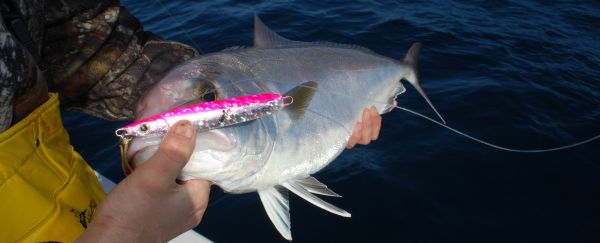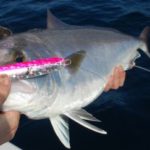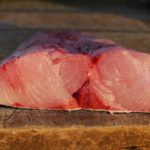
Identify greater, lesser AJs to fill the freezer
Catching amberjack is like going three rounds with a heavyweight boxer. But it’s worth it. They are a delicious table fish — better than anything else in the jack family except pompano and maybe rainbow runners.
The family is big, with 28 members in the U.S. Atlantic and Gulf of Mexico.
The fish, distributed worldwide in tropical and subtropical waters of the Atlantic, Pacific and Indian oceans, is known to scientists as Seriola dumerili. The Seriola part of the name is Latin and derived from the diminutive name for a large earthenware pot, seria. Why the name? I have no clue.
The “i” on the end of the second part of the name is a giveaway that the fish is named after a person. In this case, that person is Auguste Henri André Duméril a famous French professor of ichthyology (the study of fishes) and herpetology (the study of reptiles and amphibians) who died in 1870.
This fish is more properly known as the “greater amberjack,” to separate it from the lesser amberjack. The two species very closely resemble each other, except that the lesser AJ seldom gets to 10 pounds and is usually 4 pounds or less.
Other than its smaller size and slightly deeper body, the lesser amberjack is very difficult to separate from its greater cousin. Scientists count dorsal fin spines and rays and gill rakers, which are finger-like projections pointing forward from the first gill arch. The lesser amberjack has eight dorsal fin spines and 29 to 32 rays, compared to seven dorsal fins and 30 to 34 rays for the greater amberjack. The lesser also has 21 to 24 gill rakers and the greater has 11 to 19.
Besides being able to impress your friends with your species-identification ability, knowing the difference between the two can mean coming home with more fish. Lesser amberjacks have no closed season, a much more liberal bag limit and can be kept at smaller sizes.
Greater amberjacks, the fish we will be talking about from here on, is a fairly fast-growing species with a medium life-span. Research done by LSU scientists in the early 1990s showed that males live only until age 7, while females can live to 15 years of age. Age for age, females average only slightly larger than males.
Both sexes become old enough to spawn at 2 to 3 years old, between 32 and 38 inches in length and weighing 24 to 28 pounds. Ripe fish form spawning schools of 100 to 150 fish between February and July. Most spawning seems to occur following full moons.
Shortly before sunset, they form pairs, with the males closely following the females and constantly nuzzling their vents. Females’ heads turn black, although their fins remain light-colored. Ready-to-mate males turn colors that most anglers can’t imagine in the fish: vivid, electric blue, with scrawling on their upper sides.
While adult amberjacks can be found in both nearshore and offshore waters, spawning takes place in warmer, higher-salinity waters 15 to 70 nautical miles offshore.
Like several other species, amberjack juveniles between 1 and 8 inches long depend heavily on floating mats of sargassum weed for food and protection. At about 8 inches long, they change their lifestyle from being an open-water fish to being a bottom fish.
At about 12 inches long they begin to turn up in fishermen’s catches. Eight- to 12-inch-long fish are 5 to 6 months old.
Juvenile greater amberjack have six dark, vertical bands and strongly resemble banded rudderfish, another close relative in the jack family.
Along with the change in habitat preference comes a change in diet away from crustaceans (small, shelled, shrimp-like creatures) to fish. From 12 inches on, greater amberjack become powerful, voracious fish predators that prowl the water from the surface to depths of over 300 feet. They are most commonly found near reefs, wrecks, artificial reefs and offshore oil and gas platforms.
They might patrol for food singly or in small groups, feeding on a wide variety of fish including scad, blue runners (hardtails) and other jacks, herring, porgies, triggerfish and little tunny (bonita). A few crabs and squid also enter the diet.
Although amberjacks are now prized for their very firm white flesh, this wasn’t always the case. Until the early 1980s, most fishermen treated them with the disdain that they still show for jack crevalles.
In the 1960s, when I was a young oil-field roustabout and roughneck, it was still legal for workers to fish from oil platforms and bring their catches home with them at the ends of their shifts. I did a lot of that, and to my coworkers contemptuous amusement, I cleaned and brought home a lot of amberjacks. Nothing, it seemed was good enough for them to keep in those days, except red snappers and lemonfish, with an occasional grouper thrown in.
Amberjacks do occasionally harbor tapeworms in their flesh, usually not as often as speckled trout or as many as black drum, but they do occur. Like other tapeworms, they are harmless to man and any flesh containing them can be cut away and discarded.
Jacks, along with groupers, were also implicated in the one outbreak of ciguatera poisoning that occurred in the northern Gulf of Mexico in 2007. All the fish came from the Flower Gardens reefs located well offshore of the Texas-Louisiana border.
The toxin is produced by a naturally occurring microscopic dinoflagellate, Giambierdiscus toxicus. It grows on hard surfaces, so in the tropics where it most typically occurs, it is more common on reefs.
There is no antidote, but ciguatera poisoning is rarely fatal. It is so common in some areas of Polynesia that it is considered an almost routine event among fish consumers.




